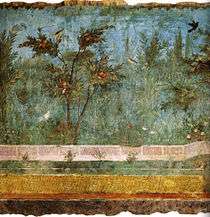Villa of Livia

The Villa of Livia (Latin: Ad Gallinas Albas) is an ancient building near Rome, Italy, probably part of Livia Drusilla's dowry brought to the Julio-Claudian dynasty. Its Latin name, Ad Gallinas Albas, referred to its breed of white chickens, but it was also famous for its laurel grove,[1] which was said by Suetonius to have auspiciously omened origins.[2]
The Villa was built and modified in four stages, the earliest of Republican date, the latest of the time of Constantine the Great. In the 19th century the villa belonged to the Convent of Santa Maria in Via Lata. It may never have passed into private hands. The villa occupied the height dominating the view down the Tiber Valley to Rome. Some of the walling that retained its terraces may still be seen.[3]
The site was rediscovered and explored as early as 1596, but it was not recognized as the Villa of Livia until the 19th century.[4] In 1863/4 a marble krater carved in refined low relief was discovered at the site and in 1867 the heroic marble statue of Augustus, the Augustus of Prima Porta, was found: it is now in the Vatican Museums (Braccio Nuovo). The magisterial Augustus is a marble copy of a bronze statue that celebrated the return in 20 BCE of the military standards captured by the Parthians in 53 BCE after the defeat of Crassus at Carrhae.

Except for works of terracing—the gardens are currently being excavated—, all that can be seen today are three vaulted subterranean rooms, from the largest of which an illusionistic fresco of a garden view, where all the plants and trees flower and fruit at once, was removed to Rome. Following cleaning and restoration, it has recently been reinstalled in the Palazzo Massimo. The vault above the fresco was covered with stucco reliefs of which only a few survive.
A new series of more meticulous modern excavations was initiated in 1970. Since 1995 exploration at the Villa has been undertaken by the Soprintendenza Archeologica di Roma, headed by Professor Gaetano Messineo, in tandem with the Swedish Institute in Rome.
 | |
|
|
References
- ↑ Pliny's Natural History 15.136f
- ↑ Suetonius, Galba 1.
- ↑ Robert Piperno, "A Walk to Malborghetto"
- ↑ F. Nardini, Roma antica IV, Roma 1820, p64f.
- ↑ "Painted Garden, Villa of Livia". Smarthistory at Khan Academy. Retrieved February 11, 2013.
Sources
| Wikimedia Commons has media related to Villa di Livia (Rome). |
- Carrara, M. (2005). "La Villa di Livia a Prima Porta da praedium suburbanum a villa Caesarum". In B. Santillo Frizell and A. Klynne. Roman Villas Around The Urbs: interaction with landscape and environment. Proceedings of a Conference at the Swedish Institute in Rome, September 17-18, 2004. Rome.
- M. Carrara, 'ad Gallinas Albas', in Lexicon Topographicum Urbis Romae: Suburbium, vol. III (2005. Rome), p. 17-24
- Jane Clark Reeder, 2001. The Villa of Livia Ad Gallinas Albas. A Study in the Augustan Villa and Garden. in series Archaeologica Transatlantica XX. (Providence: Center for Old World Archaeology and Art) (Bryn Mawr Classical Review 20)
- Calci, C.; G. Messineo (1984). "La Villa di Livia a Prima Porta". Lavori e studi di archeologia. 2.
- Allan Klynne and Peter Liljenstolpe. "Where to Put Augustus?: A Note on the Placement of the Prima Porta Statue." American Journal of Philology 121.1 (2000) pp. 121-128.
External links
Coordinates: 42°0′6.93″N 12°29′36.94″E / 42.0019250°N 12.4935944°E